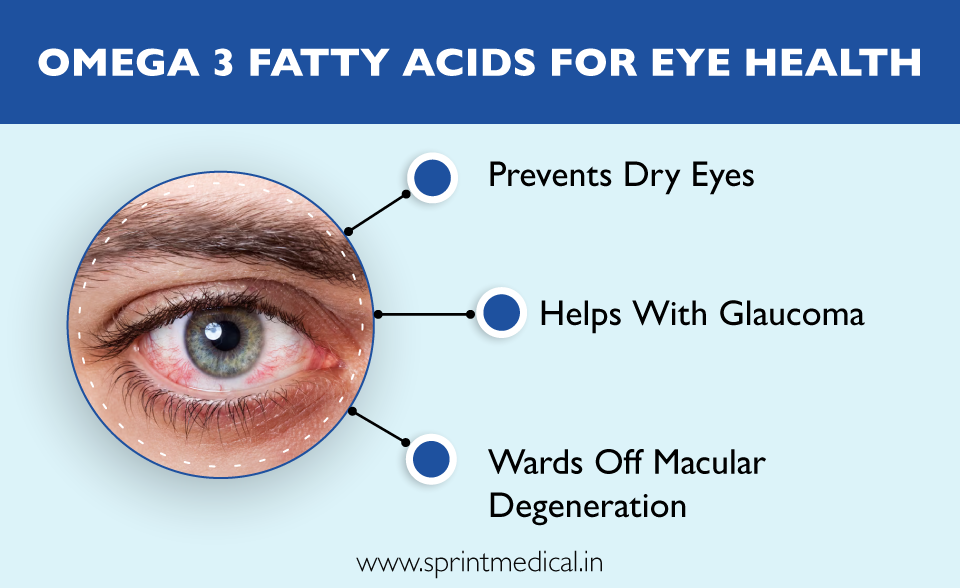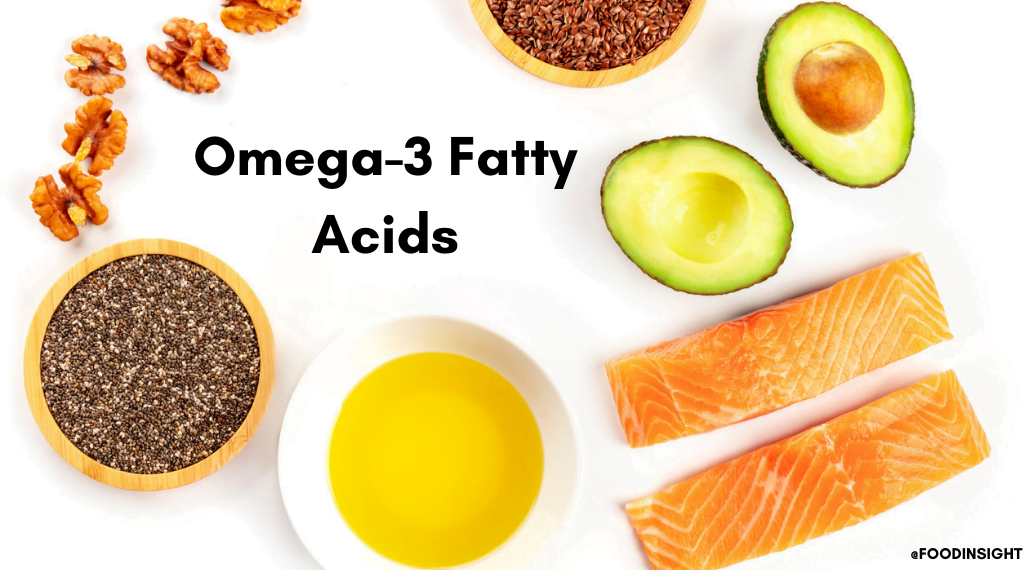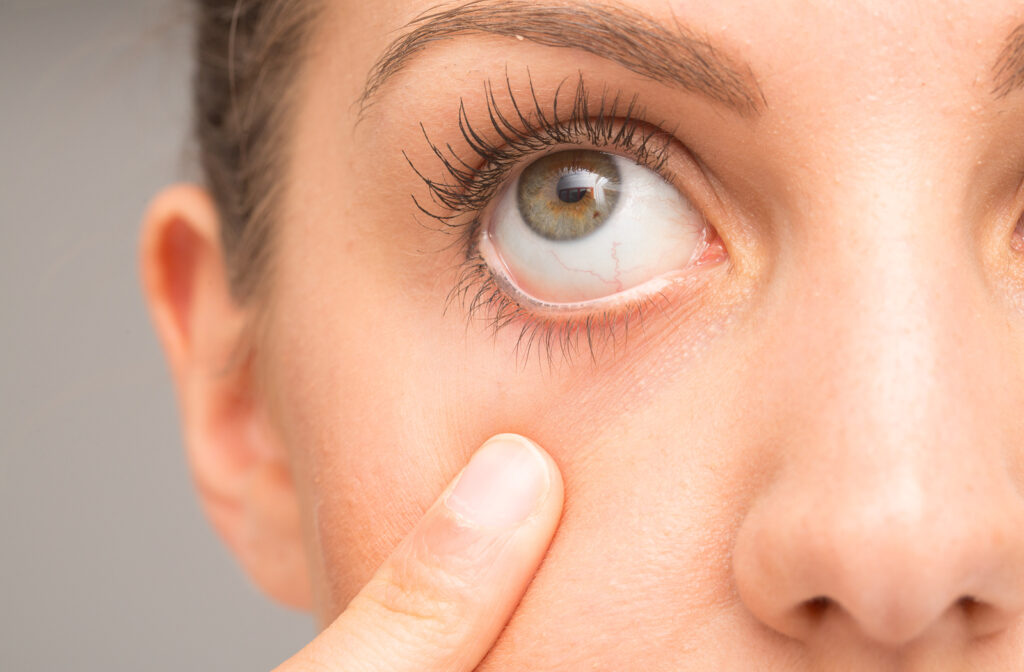
Omega-3 fatty acids, especially EPA and DHA from fish or algae, help treat dry eye disease by reducing inflammation, improving tear quality and stability, and complementing standard therapies for longer-lasting comfort and ocular surface protection.
Key takeaways
- Effective regimens generally use more than 1000 mg combined EPA+DHA daily, taken consistently for at least three months to achieve meaningful, sustained improvements.
- EPA and DHA from fatty fish or algal oils provide direct anti-inflammatory and retinal benefits; plant ALA converts poorly, giving weaker dry eye support.
- Omega-3s improve Meibomian gland oil quality and flow, slow tear evaporation, increase tear volume, and strengthen tear film stability, easing burning, itching, redness, and gritty sensations.
- Clinical trials and meta-analyses report better symptom scores, longer Tear Break-Up Time, and higher Schirmer’s test values in many patients taking omega-3 supplements.
Understanding Dry Eye Disease
Dry eye disease happens when eyes do not produce enough tears or when the tears evaporate too quickly. The tear film protecting the eyes is made of water, oils, and mucus. When these layers are unbalanced or insufficient, the eyes become dry, irritated, and sometimes inflamed. Common causes include aging, environmental factors, medication side effects, and inflammation of glands around the eye.
Current treatments include artificial tears, anti-inflammatory drops, and lifestyle changes. However, these often provide only temporary relief, making the search for effective long-term options important.
Omega-3 Fatty Acids: Types and Sources

Omega-3 fatty acids are a group of essential fats that the human body cannot produce on its own, which means they must be obtained through diet or supplements. These fats play a critical role in maintaining overall health, particularly eye health. Understanding the types of omega-3s and their sources helps to choose the right approach for protecting and improving eye function.
Main Types of Omega-3 Fatty Acids
There are three primary types of omega-3 fatty acids, each differing in structure, sources, and benefits:
- EPA (Eicosapentaenoic Acid): EPA is a long-chain omega-3 predominantly found in fatty fish like salmon, mackerel, and sardines. It is known for strong anti-inflammatory properties, making it crucial in reducing inflammation linked to dry eye disease. EPA helps regulate the body’s inflammatory response, which can ease redness, irritation, and swelling around the eyes.
- DHA (Docosahexaenoic Acid): DHA is another long-chain omega-3 fatty acid found in fatty fish and seafood. It is a major structural fat in the retina, the light-sensitive tissue at the back of the eye. DHA supports normal retinal function and overall eye development. It also helps protect against retinal cell damage caused by oxidative stress and inflammation. DHA’s presence is vital for maintaining photoreceptor health and clear vision.
- ALA (Alpha-Linolenic Acid): ALA is a plant-based omega-3 found in foods like flaxseeds, chia seeds, walnuts, and certain vegetable oils. While ALA is considered essential, its role specifically for eye health is less direct because the body converts only a small percentage of ALA into EPA and DHA less than 5% typically. This means that relying solely on ALA-rich foods for dry eye relief or retina support may be less effective compared to consuming EPA and DHA directly.
Dietary Sources of Omega-3
The best dietary sources of omega-3 fatty acids are fatty fish like salmon and mackerel for EPA and DHA, and plant-based foods like flaxseeds and walnuts for ALA.
- Fatty Fish: Fatty fish such as salmon, mackerel, sardines, trout, and anchovies are the richest natural sources of EPA and DHA. Regular consumption of these fish supports balanced omega-3 levels in the body, helping reduce ocular inflammation and supporting eye cell health.
- Seafood and Algae: Certain shellfish and marine algae provide EPA and DHA, particularly important for vegetarians and vegans who avoid fish. Algal supplements are a direct source of DHA and EPA derived from seaweed, ideal for those seeking plant-based omega-3s with similar benefits to fish oil.
- Plant-Based Sources: Flaxseeds, chia seeds, walnuts, hemp seeds, and canola oil are high in ALA. While beneficial for overall health, these need to be converted in the body to EPA and DHA for optimal eye benefits. This conversion is inefficient, so eating these alone may offer limited protection or symptom relief in dry eye conditions.
How Omega-3 Helps Relieve Dry Eye Symptoms

Omega-3 fatty acids provide relief for dry eye symptoms mainly through their ability to reduce inflammation and improve the function of the eye’s oil-producing glands. These effects combine to protect the surface of the eyes and enhance tear quality and stability.
- Anti-inflammatory Effects: Omega-3s help create substances called resolvins and protectins, which are powerful inflammation-fighting molecules. By reducing inflammation in the tear glands and on the eye surface, omega-3s calm irritation and prevent the chronic inflammation that worsens dry eye symptoms like redness, burning, and discomfort.
- Improved Meibomian Gland Function: The Meibomian glands around the eyelids produce the oily part of the tear film. This oil prevents tears from evaporating too quickly, keeping eyes moist. Omega-3s improve both the quality and flow of this oil, helping the tear film last longer and reducing dryness caused by tear evaporation.
- Better Tear Production and Stability: Regular omega-3 supplementation can increase tear volume and strengthen the tear film’s stability. A stable tear film protects the eye surface from dryness and reduces symptoms like itching or the feeling of foreign particles in the eyes. This leads to longer-lasting moisture and comfort.
- Protection Against Oxidative Stress: The cells lining the eyes are vulnerable to damage from environmental factors like wind, smoke, and screen exposure. Omega-3 fatty acids protect these cells by reducing oxidative stress, which is the damage caused by harmful molecules known as free radicals. This protection helps maintain healthy eye tissues and prevents further irritation and injury.
Clinical Evidence Supporting Omega-3 for Dry Eye
A wide range of scientific studies has explored the effectiveness of omega-3 supplements in relieving dry eye symptoms. These investigations include randomized controlled trials, meta-analyses, and systematic reviews, providing valuable insights into how omega-3 impacts this common eye condition.
Symptom Improvement
Many clinical trials consistently report that omega-3 supplementation reduces common dry eye symptoms such as burning, itchiness, a gritty feeling, and eye redness. Participants in these studies often describe noticeable relief, which improves their comfort and daily functioning. Meta-analyses of randomized controlled trials involving thousands of patients have confirmed statistically significant improvements in symptom scores after omega-3 intake. Higher doses of omega-3, longer treatment duration, and increased EPA content correlate with greater symptom relief. However, results can vary due to individual factors and dry eye subtypes, but overall, omega-3 shows a reliable benefit for many sufferers.Many clinical trials consistently report that omega-3 supplementation reduces common dry eye symptoms such as burning, itchiness, a gritty feeling, and eye redness. Participants in these studies often describe noticeable relief, which improves their comfort and daily functioning. Meta-analyses of randomized controlled trials involving thousands of patients have confirmed statistically significant improvements in symptom scores after omega-3 intake. Higher doses of omega-3, longer treatment duration, and increased EPA content correlate with greater symptom relief. However, results can vary due to individual factors and dry eye subtypes, but overall, omega-3 shows a reliable benefit for many sufferers.
Clinical Test Improvements
Clinical test improvements following omega-3 supplementation for dry eye include significant increases in Tear Break-Up Time (TBUT), which indicates better tear film stability, and enhanced Schirmer’s test results, reflecting increased tear production, both contributing to reduced dryness and eye irritation.
- Tear Break-Up Time (TBUT): TBUT measures how long tears remain stable on the eye before evaporating. Numerous studies show that omega-3 supplementation can significantly increase TBUT, indicating improved tear film stability which helps prevent dryness and irritation.
- Schirmer’s Test: This test measures tear volume by quantifying how much tears are produced in a set time. Many trials report enhanced tear production after daily omega-3 intake, especially in individuals whose dry eye involves reduced tear secretion.
Importance of Dosage and Duration
Research indicates that higher doses of EPA and DHA, usually above 1000 mg per day combined, taken consistently for at least three months, yield the best improvements. Longer treatment duration correlates with greater symptom relief and eyes’ functional restoration.
Mixed Controversies and Variability in Results
Some large studies, including well-known trials, have reported no significant difference between omega-3 and placebo groups. These mixed findings suggest that omega-3 benefits might depend on factors such as:
- The specific subtype of dry eye (evaporative vs aqueous deficient)
- Individual variations in absorption and response to supplements
- Baseline dietary intake of omega-3 or severity of disease
Safety and Tolerability
Omega-3 supplements are generally safe and well tolerated. Most studies report minor side effects such as mild stomach upset or fishy aftertaste in a small percentage of users. No serious adverse effects have been linked to typical doses used for dry eye treatment.
Integrating Omega-3 with Dry Eye Management
Omega-3 supplementation works best as part of a broader dry eye care plan including:
- Maintaining eyelid hygiene and warm compresses to improve gland function
- Using artificial tears for added moisture
- Avoiding environmental triggers like smoke or excessive screen time
- Regular eye checkups to monitor dry eye progression and adjust treatments
Omega-3s tend to work better for dry eye caused by meibomian gland dysfunction but may also help other subtypes.
Conclusion
Dry eye disease causes irritation due to unstable or insufficient tears. Omega-3 fatty acids, mainly EPA and DHA from fish, reduce inflammation, improve eye oil gland function, and enhance tear production. These effects lead to better tear stability and relief from symptoms like burning and redness. Clinical evidence supports omega-3 supplements, showing improved tear quality and symptom reduction, especially with doses over 1000 mg daily taken consistently for several months. Plant-based ALA offers less eye benefit due to poor conversion. Safe and effective, omega-3s work best combined with other dry eye therapies for lasting comfort and eye health protection.
FAQS
How exactly do omega-3 fatty acids relieve dry eye symptoms?
Omega-3s reduce inflammation by helping the body produce resolvins and protectins, which calm irritated tissues in and around the eye. They also improve the quality and flow of the oily secretion from the Meibomian glands, which prevents tears from evaporating too quickly. This combination helps stabilize the tear film and increases tear production, reducing symptoms like burning, itching, redness, and foreign-body sensation.
Which omega-3 fatty acids are most important for eye health?
The two main omega-3s critical for eye health are EPA (eicosapentaenoic acid) and DHA (docosahexaenoic acid), both found in high amounts in fatty fish. DHA is a structural component of the retina, essential for clear vision, while EPA mainly controls inflammation. ALA (alpha-linolenic acid), found in plants, has limited direct eye benefits because the body converts only a small amount into EPA and DHA.
How long does it typically take to see improvements in dry eye symptoms from taking omega-3 supplements?
Most clinical studies report noticeable symptom relief after continuous omega-3 supplementation for 3 to 6 months. Longer use often leads to better tear film stability and sustained symptom reduction.
What is the recommended dose of omega-3 fatty acids for managing dry eye disease?
Clinical trials generally use daily doses of 1000 to 2000 mg of combined EPA and DHA for effective symptom improvement. Lower doses may be less effective, and it’s important to maintain consistent intake over several months.
Are omega-3 supplements safe, and what side effects might I expect?
Omega-3 supplements are safe for most people when taken at recommended doses. Some users report mild side effects, such as fishy aftertaste, gastrointestinal discomfort, or loose stools. Serious adverse effects are rare. However, people on medications like blood thinners should consult a healthcare professional to avoid interactions.
Can omega-3 supplements replace traditional dry eye treatments like artificial tears?
Omega-3 supplements are best used as part of a comprehensive dry eye management plan. They complement treatments like artificial tears, warm compresses, and eyelid hygiene by targeting underlying inflammation and gland function, rather than just relieving symptoms temporarily.
Are there omega-3 options suitable for vegetarians or vegans?
Yes, algae-based omega-3 supplements provide EPA and DHA without fish products, making them suitable for vegetarians and vegans. These sources offer similar benefits to fish oil for dry eye relief.
Do omega-3 supplements help all types of dry eye disease equally?
Omega-3s are particularly effective for evaporative dry eye caused by Meibomian gland dysfunction. They may be less effective for purely aqueous-deficient dry eye but can still provide benefit due to their anti-inflammatory properties.
Can omega-3 supplements interact with other medications or health conditions?
Omega-3s can have a mild blood-thinning effect, so people taking anticoagulants or with bleeding disorders should seek medical advice. Otherwise, omega-3s are safe for most individuals, including those with chronic diseases.
Is it possible to get enough omega-3 from diet alone to improve dry eye symptoms?
While eating fatty fish regularly may help improve omega-3 status, many people struggle to consume sufficient amounts consistently. Supplements provide a reliable and concentrated source of EPA and DHA that can more effectively support eye health and manage dry eye symptoms.
What should I look for in a high-quality omega-3 supplement?
Choose supplements with high concentrations of EPA and DHA, preferably in the re-esterified triglyceride (rTG) form for better absorption. Look for products tested for purity and free from heavy metals or contaminants. Some supplements also include antioxidants like vitamin E to protect the oils.
Can lifestyle changes enhance the benefits of omega-3 for dry eyes?
Yes, adopting habits that reduce eye strain, maintaining eyelid hygiene, avoiding smoke or dry air, and using protective eyewear can improve outcomes when combined with omega-3 supplementation.
Reference
- Epitropoulos AT, et al. Efficacy of Omega-3 Intake in Managing Dry Eye Disease. Clin Ophthalmol. 2023.
https://www.ncbi.nlm.nih.gov/pmc/articles/PMC10672334/ - Bhargava R, Kumar P. The Role of Omega-3 Essential Fatty Acids in Dry Eye Syndrome: A Review. Int J Curr Ophthalmol. 2017.
https://www.clinophthaljournal.com/article.asp?issn=2395-1443;year=2017;volume=5;issue=4;spage=230;epage=234;aulast=Bhargava - Asbell PA, et al. Efficacy of Marine ω-3 Fatty Acid Supplementation vs Placebo for Dry Eye Disease. JAMA Ophthalmol. 2022.
https://jamanetwork.com/journals/jamaophthalmology/fullarticle/2793162 - Omega-3 Fatty Acids – Health Professional Fact Sheet. National Institutes of Health, Office of Dietary Supplements. 2025.
https://ods.od.nih.gov/factsheets/Omega3FattyAcids-HealthProfessional/ - Study on Omega-3 Fatty Acids and Dry Eye. ClinicalTrials.gov. 2010.
https://clinicaltrials.gov/ct2/show/NCT01213342 - Stoney Creek Eye Care. How Omega-3’s Can Help Treat Dry Eye. 2021.
https://stoneycreekeyecare.com/how-omega-3s-can-help-treat-dry-eye/
Autum Harkins is a CNS with an MS in Clinical Nutrition from Maryland University of Integrative Health (2017) and 8 years in integrative clinics. She develops individualized protocols for deficiencies, digestive health, and women’s wellness, prioritizing third-party-tested supplements. Autum contributes to case series and webinars and mentors practitioners on lab interpretation. Credentials: CNS Board (ANA/BCNS) number, state nutrition licensure where applicable, and professional memberships with links.

